Global Very Small Aperture Terminal (VSAT) Market: By Type, By Design, By Solution, By Platform, By Frequency, By Network Architecture, By End Use, By Industry Vertical, By Region & Segmental Insights Trends and Forecast, 2024 – 2034
- Industry: Technology
- Report ID: TNR-110-1114
- Number of Pages: 420
- Table/Charts : Yes
- June, 2024
- Base Year : 2024
- No. of Companies : 10+
- No. of Countries : 29
- Views : 10183
- Covid Impact Covered: Yes
- War Impact Covered: Yes
- Formats : PDF, Excel, PPT
A Very Small Aperture Terminal (VSAT) is a satellite communication system that utilizes small dish antennas, typically ranging from 0.75 to 2.4 meters in diameter, to transmit and receive data via satellite. VSAT technology is widely used for providing internet and communication services in remote and underserved areas where traditional terrestrial networks are unavailable or unreliable. It supports a variety of applications including broadband internet access, VoIP, video conferencing, and private networks for businesses and government agencies. VSAT systems are crucial for industries like maritime, aviation, energy, and emergency response, offering reliable connectivity in challenging environments. The technology’s flexibility, quick deployment, and ongoing advancements in satellite capabilities make it a vital component of global communication infrastructure.
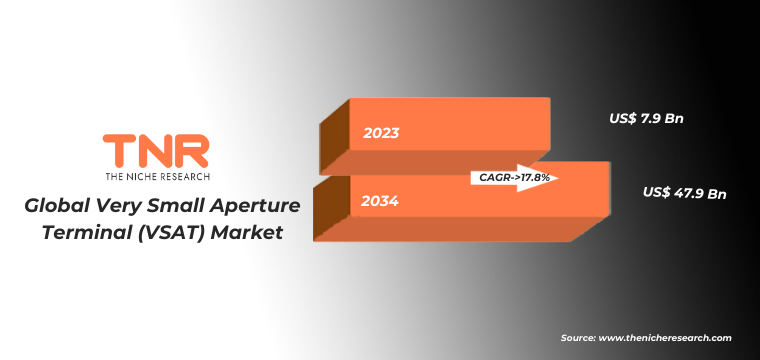
The demand for Very Small Aperture Terminal (VSAT) systems is primarily driven by the need for reliable communication services in remote and underserved areas. VSAT technology offers a viable solution for businesses, government agencies, and communities seeking to bridge the digital divide by providing internet access where traditional terrestrial infrastructure is lacking. Industries such as maritime, oil and gas, mining, and agriculture heavily rely on VSAT for uninterrupted connectivity in remote locations, supporting operational efficiency and safety.
Additionally, the increasing demand for broadband internet, coupled with the proliferation of Internet of Things (IoT) devices, further fuels the adoption of VSAT systems. As technological advancements continue to enhance the performance and affordability of satellite communication, the demand for VSAT is expected to grow, addressing the connectivity needs of diverse sectors worldwide
. In Terms of Revenue, the Global Very Small Aperture Terminal (VSAT) Market was Worth US$ 7.9 Bn in 2023, Anticipated to Witness CAGR of 17.8% During 2024 – 2034.

Global Very Small Aperture Terminal (VSAT) Market Dynamics
Rural Connectivity: One of the primary drivers is the need for internet access in remote and rural areas where traditional broadband infrastructure is lacking. VSAT provides a reliable solution to bridge this digital divide. Businesses and government agencies require robust communication networks for operations in remote locations, including mining, oil and gas, and defense sectors. VSAT’s ability to offer reliable connectivity in these challenging environments fuels market growth.
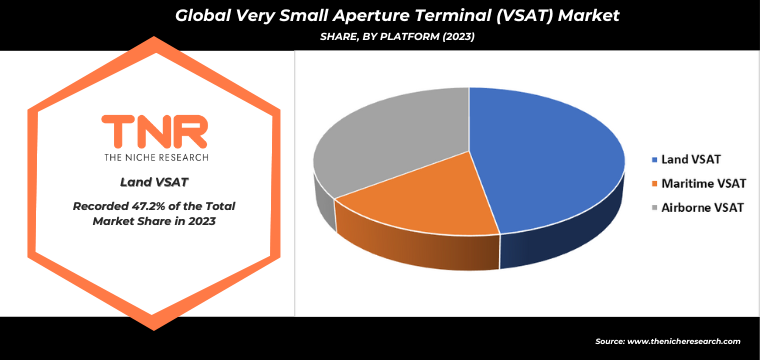
Technological Advancements: Continuous improvements in satellite technology, including the development of high-throughput satellites (HTS), enhance the capacity, speed, and cost-effectiveness of VSAT services, making them more attractive to a broader range of users. VSAT’s quick deployment and resilience make it a critical tool for disaster recovery efforts and emergency response, ensuring communication remains uninterrupted during crises.
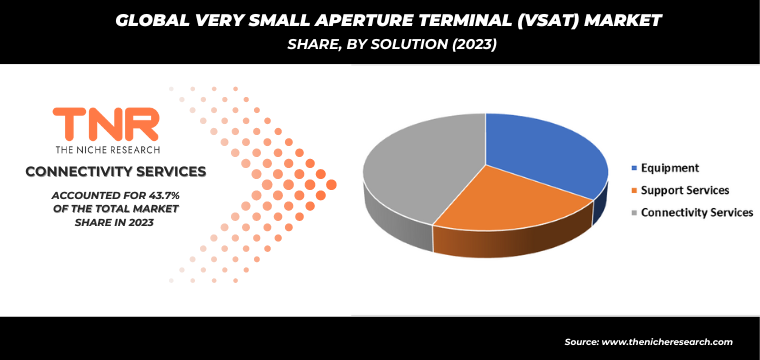
Internet of Things (IoT): The proliferation of IoT devices and applications necessitates extensive and reliable network coverage, which VSAT systems can provide, driving further demand. Regulatory policies and licensing requirements in different regions can impact the deployment and expansion of VSAT networks, either facilitating growth or posing challenges.
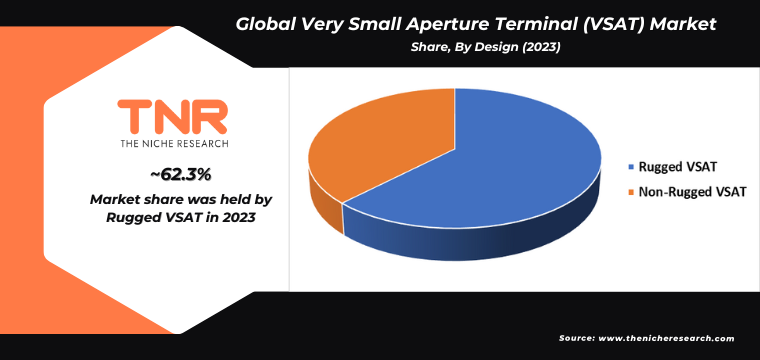
Standard VSAT Segment Has Garnered Major Market Share in the Global Very Small Aperture Terminal (VSAT) Market During the Forecast Period (2024 – 2034).
The demand for standard Very Small Aperture Terminal (VSAT) technology is driven by the necessity for reliable, wide-reaching communication solutions, particularly in remote and underserved areas. As businesses and governments seek to enhance connectivity for operations in isolated regions, VSAT offers a critical alternative to terrestrial networks, providing dependable internet and communication services. The expansion of remote work, increasing reliance on the Internet of Things (IoT), and the need for efficient disaster recovery solutions further amplify the demand for VSAT. Moreover, sectors such as maritime, aviation, and energy depend on VSAT for seamless communication and data transfer. Continuous advancements in satellite technology, enhancing the capacity and performance of VSAT systems, also contribute to the growing demand.
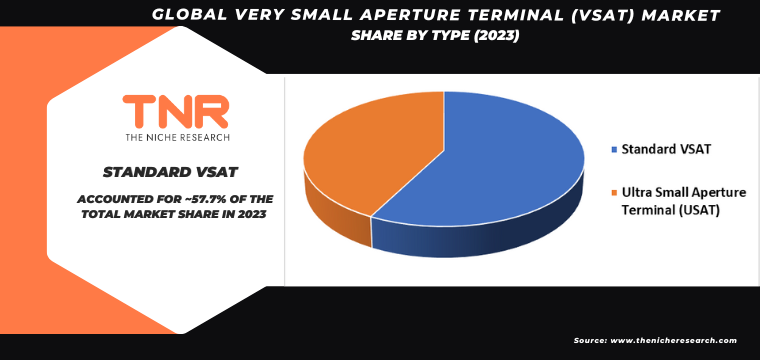
By End Use Broadband Networks Segment had the Highest Share in the Global Very Small Aperture Terminal (VSAT) Market in 2023.
The increasing demand for very small aperture terminal (VSAT) technology within broadband networks is driven by the need for ubiquitous and reliable internet access across various sectors. As remote work and digital transformation trends accelerate, businesses and consumers alike require stable and high-speed connectivity, particularly in rural and underserved regions where traditional broadband infrastructure is insufficient or non-existent. VSAT technology offers a robust solution by providing high-quality internet access via satellite, circumventing the limitations of terrestrial networks.
This is particularly crucial for enterprises operating in remote locations, such as mining, agriculture, and maritime industries, which depend on seamless data communication for operational efficiency. Additionally, the proliferation of smart devices and the Internet of Things (IoT) necessitates extensive and reliable network coverage, further fuelling the adoption of VSAT systems. Emergency response and disaster recovery operations also benefit significantly from the quick deployment and resilience of VSAT networks. As technological advancements continue to enhance the capacity and cost-effectiveness of VSAT solutions, their integration into broadband networks is becoming increasingly vital, driving substantial growth in demand.

By Region North America Dominated the Global Very Small Aperture Terminal (VSAT) Market in 2023.
The demand for Very Small Aperture Terminal (VSAT) technology in North America is driven by several critical factors. With the ongoing expansion of remote work and the increasing need for reliable internet connectivity in rural and underserved areas, VSAT provides an essential solution for bridging the digital divide. Businesses and government agencies are heavily investing in VSAT to ensure continuous communication and data transfer capabilities, especially in remote locations where terrestrial infrastructure is lacking. Additionally, the rise of Internet of Things (IoT) applications and the growth of smart technologies necessitate robust and reliable satellite communication networks.
The energy sector, including offshore oil and gas operations, relies on VSAT for monitoring and operational efficiency. Disaster recovery efforts also benefit from VSAT’s quick deployment and reliable performance. Furthermore, the ongoing development and launch of new high-throughput satellites are enhancing the capacity and performance of VSAT systems, making them more attractive and cost-effective. These factors collectively drive the growing demand for VSAT services across North America, highlighting its critical role in modern communication infrastructure.

Competitive Landscape: Global Very Small Aperture Terminal (VSAT) Market:
- EchoStar
- Gilat Satellite
- Inmarsat Global Limited
- L3Harris Technologies Inc.
- Mitsubishi Electric Corporation
- Networks Ltd.
- Orbit Communication Systems Ltd.
- Singtel
- Thales Group
- Viasat Inc.
- Other Industry Participants
Global Very Small Aperture Terminal (VSAT) Market Scope
| Report Specifications | Details |
| Market Revenue in 2023 | US$ 7.9 Bn |
| Market Size Forecast by 2034 | US$ 47.9 Bn |
| Growth Rate (CAGR) | 17.8% |
| Historic Data | 2016 – 2022 |
| Base Year for Estimation | 2023 |
| Forecast Period | 2024 – 2034 |
| Report Inclusions | Market Size & Estimates, Market Dynamics, Competitive Scenario, Trends, Growth Factors, Market Determinants, Key Investment Segmentation, Product/Service/Solutions Benchmarking |
| Segments Covered | By Type, By Design, By Solution, By Platform, By Frequency, By Network Architecture, By End Use, By Industry Vertical, By Region |
| Regions Covered | North America, Europe, Asia Pacific, Middle East & Africa, Latin America |
| Countries Covered | U.S., Canada, Mexico, Rest of North America, France, The UK, Spain, Germany, Italy, Nordic Countries (Denmark, Finland, Iceland, Sweden, Norway), Benelux Union (Belgium, The Netherlands, Luxembourg), Rest of Europe, China, Japan, India, New Zealand, Australia, South Korea, Southeast Asia (Indonesia, Thailand, Malaysia, Singapore, Rest of Southeast Asia), Rest of Asia Pacific, Saudi Arabia, UAE, Egypt, Kuwait, South Africa, Rest of Middle East & Africa, Brazil, Argentina, Rest of Latin America |
| Key Players | EchoStar, Gilat Satellite, Inmarsat Global Limited, L3Harris Technologies Inc., Mitsubishi Electric Corporation, Networks Ltd., Orbit Communication Systems Ltd., Singtel, Thales Group, Viasat Inc. |
| Customization Scope | Customization allows for the inclusion/modification of content pertaining to geographical regions, countries, and specific market segments. |
| Pricing & Procurement Options | Explore purchase options tailored to your specific research requirements |
| Contact Details | Consult With Our Expert
Japan (Toll-Free): +81 663-386-8111 South Korea (Toll-Free): +82-808- 703-126 Saudi Arabia (Toll-Free): +966 800-850-1643 United Kingdom: +44 753-710-5080 United States: +1 302-232-5106 E-mail: askanexpert@thenicheresearch.com
|
Global Very Small Aperture Terminal (VSAT) Market
By Type
- Standard VSAT
- Ultra Small Aperture Terminal (USAT)
By Design
- Rugged VSAT
- Non-Rugged VSAT
By Solution
- Equipment
- Support Services
- Connectivity Services
By Platform
- Land VSAT
- Maritime VSAT
- Airborne VSAT
By Frequency
- Ku-band
- Ka-band
- X-band
- C-band
- L-band
- S-band
- Multi-band
By Network Architecture
- Star Topology
- Mesh Topology
- Hybrid Topology
- Point-to-Point links
By End Use
- Broadband Networks
- Voice Communication
- Private Network Service
- Broadcast
- Others
By Industry Vertical
- Energy & Power
- Healthcare
- Education
- BFSI
- Media and Entertainment
- Retail
- Transportation and Logistics
- Telecommunications
- Maritime
- Aviation
- Agriculture and forestry
- Mining and Construction
- Manufacturing
- Automotive
- Government and Defense
- Others
By Region
- North America (U.S., Canada, Mexico, Rest of North America)
- Europe (France, The UK, Spain, Germany, Italy, Nordic Countries (Denmark, Finland, Iceland, Sweden, Norway), Benelux Union (Belgium, The Netherlands, Luxembourg), Rest of Europe)
- Asia Pacific (China, Japan, India, New Zealand, Australia, South Korea, Southeast Asia (Indonesia, Thailand, Malaysia, Singapore, Rest of Southeast Asia), Rest of Asia Pacific)
- Middle East & Africa (Saudi Arabia, UAE, Egypt, Kuwait, South Africa, Rest of Middle East & Africa)
- Latin America (Brazil, Argentina, Rest of Latin America)
Report Layout
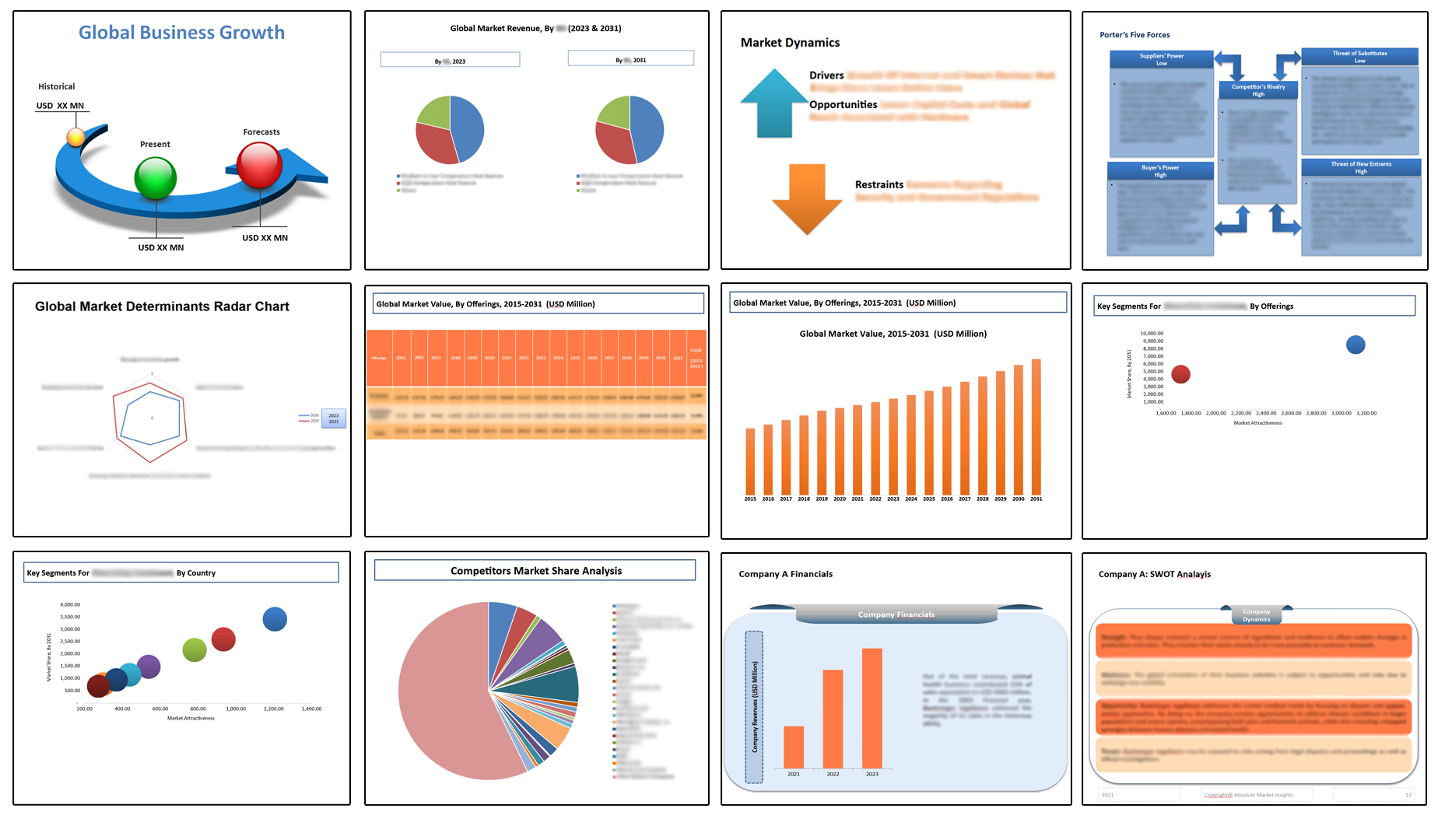
Table of Contents
Note: This ToC is tentative and can be changed according to the research study conducted during the course of report completion.
**Exclusive for Multi-User and Enterprise User.
Global Very Small Aperture Terminal (VSAT) Market
By Type
- Standard VSAT
- Ultra Small Aperture Terminal (USAT)
By Design
- Rugged VSAT
- Non-Rugged VSAT
By Solution
- Equipment
- Support Services
- Connectivity Services
By Platform
- Land VSAT
- Maritime VSAT
- Airborne VSAT
By Frequency
- Ku-band
- Ka-band
- X-band
- C-band
- L-band
- S-band
- Multi-band
By Network Architecture
- Star Topology
- Mesh Topology
- Hybrid Topology
- Point-to-Point links
By End Use
- Broadband Networks
- Voice Communication
- Private Network Service
- Broadcast
- Others
By Industry Vertical
- Energy & Power
- Healthcare
- Education
- BFSI
- Media and Entertainment
- Retail
- Transportation and Logistics
- Telecommunications
- Maritime
- Aviation
- Agriculture and forestry
- Mining and Construction
- Manufacturing
- Automotive
- Government and Defense
- Others
By Region
- North America (U.S., Canada, Mexico, Rest of North America)
- Europe (France, The UK, Spain, Germany, Italy, Nordic Countries (Denmark, Finland, Iceland, Sweden, Norway), Benelux Union (Belgium, The Netherlands, Luxembourg), Rest of Europe)
- Asia Pacific (China, Japan, India, New Zealand, Australia, South Korea, Southeast Asia (Indonesia, Thailand, Malaysia, Singapore, Rest of Southeast Asia), Rest of Asia Pacific)
- Middle East & Africa (Saudi Arabia, UAE, Egypt, Kuwait, South Africa, Rest of Middle East & Africa)
- Latin America (Brazil, Argentina, Rest of Latin America)
The Niche Research approach encompasses both primary and secondary research methods to provide comprehensive insights. While primary research is the cornerstone of our studies, we also incorporate secondary research sources such as company annual reports, premium industry databases, press releases, industry journals, and white papers.
Within our primary research, we actively engage with various industry stakeholders, conducting paid interviews and surveys. Our meticulous analysis extends to every market participant in major countries, allowing us to thoroughly examine their portfolios, calculate market shares, and segment revenues.
Our data collection primarily focuses on individual countries within our research scope, enabling us to estimate regional market sizes. Typically, we employ a bottom-up approach, meticulously tracking trends in different countries. We analyze growth drivers, constraints, technological innovations, and opportunities for each country, ultimately arriving at regional figures.Our process begins by examining the growth prospects of each country. Building upon these insights, we project growth and trends for the entire region. Finally, we utilize our proprietary model to refine estimations and forecasts.
Our data validation standards are integral to ensuring the reliability and accuracy of our research findings. Here’s a breakdown of our data validation processes and the stakeholders we engage with during our primary research:
- Supply Side Analysis: We initiate a supply side analysis by directly contacting market participants, through telephonic interviews and questionnaires containing both open-ended and close-ended questions. We gather information on their portfolios, segment revenues, developments, and growth strategies.
- Demand Side Analysis: To gain insights into adoption trends and consumer preferences, we reach out to target customers and users (non-vendors). This information forms a vital part of the qualitative analysis section of our reports, covering market dynamics, adoption trends, consumer behavior, spending patterns, and other related aspects.
- Consultant Insights: We tap into the expertise of our partner consultants from around the world to obtain their unique viewpoints and perspectives. Their insights contribute to a well-rounded understanding of the markets under investigation.
- In-House Validation: To ensure data accuracy and reliability, we conduct cross-validation of data points and information through our in-house team of consultants and utilize advanced data modeling tools for thorough verification.
The forecasts we provide are based on a comprehensive assessment of various factors, including:
- Market Trends and Past Performance (Last Five Years): We accurately analyze market trends and performance data from preceding five years to identify historical patterns and understand the market’s evolution.
- Historical Performance and Growth of Market Participants: We assess the historical performance and growth trajectories of key market participants. This analysis provides insights into the competitive landscape and individual company strategies.
- Market Determinants Impact Analysis (Next Eight Years): We conduct a rigorous analysis of the factors that are projected to influence the market over the next eight years. This includes assessing both internal and external determinants that can shape market dynamics.
- Drivers and Challenges for the Forecast Period:Identify the factors expected to drive market growth during the forecast period, as well as the challenges that the industry may face. This analysis aids in deriving an accurate growth rate projection.
- New Acquisitions, Collaborations, or Partnerships: We keep a close watch on any new acquisitions, collaborations, or partnerships within the industry. These developments can have a significant impact on market dynamics and competitiveness.
- Macro and Micro Factors Analysis:A thorough examination of both macro-level factors (e.g., economic trends, regulatory changes) and micro-level factors (e.g., technological advancements, consumer preferences) that may influence the market during the forecast period.
- End-User Sentiment Analysis: To understand the market from the end-user perspective, we conduct sentiment analysis. This involves assessing the sentiment, preferences, and feedback of the end-users, which can provide valuable insights into market trends.
- Perspective of Primary Participants: Insights gathered directly from primary research participants play a crucial role in shaping our forecasts. Their perspectives and experiences provide valuable qualitative data.
- Year-on-Year Growth Trend: We utilize a year-on-year growth trend based on historical market growth and expected future trends. This helps in formulating our growth projections, aligning them with the market’s historical performance.
Research process adopted by TNR involves multiple stages, including data collection, validation, quality checks, and presentation. It’s crucial that the data and information we provide add value to your existing market understanding and expertise. We have also established partnerships with business consulting, research, and survey organizations across regions and globally to collaborate on regional analysis and data validation, ensuring the highest level of accuracy and reliability in our reports.









